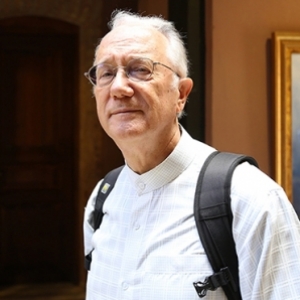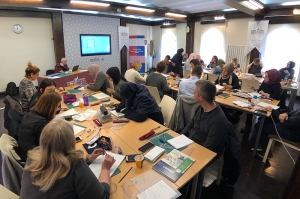School of Geometric Patterns in Islamic Art
Workshop 1 : Introduction to Decagonal Patterns
This course is devoted to foundations of decagonal pattern design in Islamic arts. We will learn the fundamentals of the gereh method – the method that was used for many centuries in Central Asia to design geometric patterns. Then we will concentrate on some essential styles of decagonal patterns. The emphasis will be placed on Persian style designs. We will cover most of the material from the red book that we used in spring 2019. However, a number of new designs will be added. One important addition will be the Isfahani style of visual inflation method. This method will be used for the final project.
Schedule – day by day
Day 1. Gereh method and its rules, some basic styles of decagonal patterns
Day 2. Patterns on decagonal grids
Day 3. Proportions of patterns and constructions of contours
Day 4. Kukeldash Madrasah and Persian styles of decagonal patterns
Day 5.The Isfahani visual inflation method, final project.
Depending on our drawing skills some topics may change or move to the next day. Depending on the weather we may have an excursion or excursions to some mosques in Istanbul or other places. The excursion(s) will be after teaching hours. Some of these places are far away. Thus you will need comfortable shoes if you want to visit remote places.
Workshop Schedule:
September 28 - October 02, 2020 from 10.00 - 16.00 daily.
Workshop Level: Basic / Intermediate Level
Participants: Architects, mathematics teachers and students, artists.
Course Language: English
Note 1: Due to the pandemic our workshop is planned to be conducted some time in 2021.
Note 2: Also, we are planning to conduct the Geometric Patterns Workshop online.
Workshop 2 : Geometric Patterns from Topkapı Scroll
The Topkapi scroll is a famous collection of historical geometric patterns. Many of them are decagonal patterns. For this reason, this course will be available only for those participants who have completed the introductory course where we have covered the decagonal patterns. We did such a course in spring 2019 and, of course, we will do it on March 23-27, 2020. The course is not extremely difficult but the amount of drawing will be large. Thus your drawing skills are essential. Although Topkapi scroll is stored in the Topkapi Museum, its content is completely Persian (style or language?). Thus the course will be a celebration of Persian style pattern design. All examples in this course will be taken from the Topkapi scroll, but they will also be illustrated by real existing designs from Iran (Isfahan area). We will discuss also a number of examples that are not on the scroll, but they follow the same designing techniques as patterns from the scroll. The two Persian visual inflation techniques will be examined and used in designing complex patterns. We will show how designers used them to create large panels in the Chahar Bagh Theological School and a few other places. Currently, there is no textbook for this course. You will have to make your own notes. For this reason, you may need an extra notebook. One of the elements of this course will be excursions to Istanbul mosques. But we have to remember that most of the patterns in Istanbul are more complex Ottoman style designs. However, we still will be able to find a few typical Persian style designs. We will be also be gathering information for an advanced course on Ottoman designs and kundekari art. If time permits, we will discuss techniques of drawing patterns for kundekari designs and/or mirror designs.
Workshop Schedule:
05 - 09 October, 2020 from 10.00 - 16.00 daily.
Workshop Level: Advanced Level
Participants: Architects, mathematics teachers and students, artists.
Course Language: English
Note 1: Due to the pandemic our workshop is planned to be conducted some time in 2021.
Note 2: Also, we are planning to conduct the Geometric Patterns Workshop online.
Materials for Both Courses
Both courses are hand drawing courses. You will need some very basic tools and materials. Although Istanbul Design Center provides all these materials, you still can bring your favorite pencil, compass, etc.
Here is a complete list:
1. Two pencils – one soft (it can be something between 2B and 6B), one hard pencil (F or H).
2. Tracing paper and drawing cardboard (both A4). Many patterns in the second course will be done on a large scale (A3 at least). Thus for the second course, we may need drawing cardboard A3 size.
3. Compasses, ruler and one drawing triangle (just one and it doesn’t matter with which angle: 30 or 45 degrees). Note – there is no drawing triangle for decagonal angles 18, 36, 54 and 72 degrees. We will have to make them on our own.
4. Pigment liner e.g. uniPIN Fine Line (0.5) or Staedtler 308 (0.5), etc.

Miroslaw Majewski
(Prof. Dr) is a former Professor of the New York Institute of Technology. Currently, Professor Emeritus of NYIT. Many years of research in the geometry of art and technology for mathematics. Author of numerous books and publications (many of them related to the geometry of patterns). Designer of many geometric patterns – some are reconstructions of well-known patterns, and some of them are entirely new.











